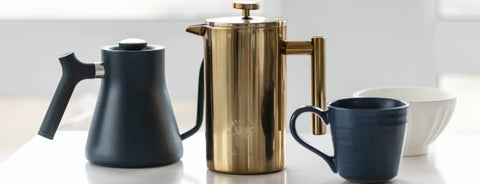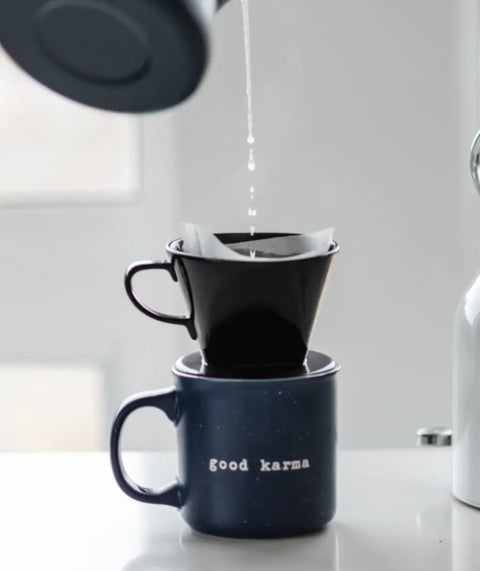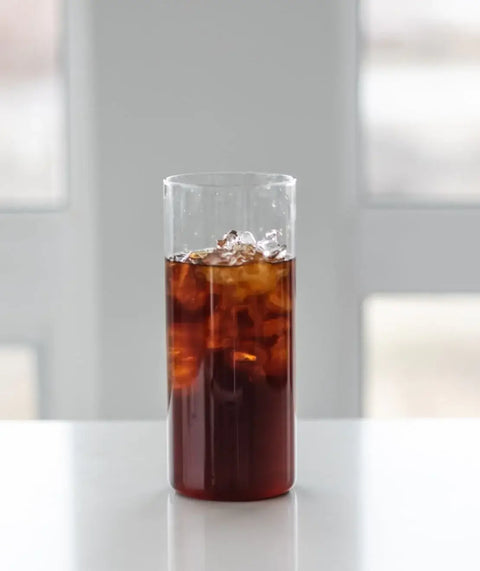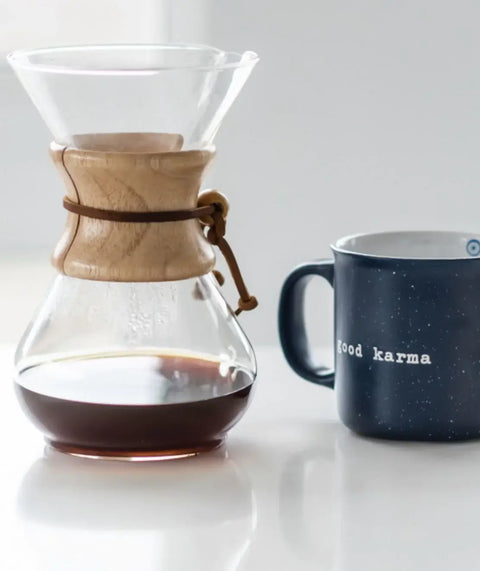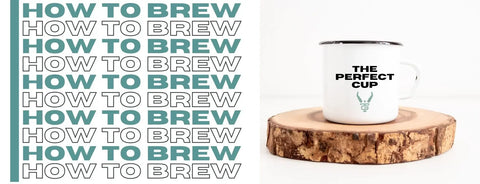
How To Make The Perfect Pot Of Coffee
If you like your coffee hot, or like me, piping hot, then you know that it is the finer details that make all difference when it comes to taste and temperature.
Avid coffee enthusiasts swear by the fact that filtered water is the only way forward, but many elements when combined well will result in less coffee being left in coffee cups around the world.
There is really no magic to brewing the perfect pot of Twisted Goat Coffee. It's basically a little ground coffee, add hot water and you are ready to brew.
But with a few simple tips and tricks, you can brew not just a good coffee, but rather the best pot of coffee that is perfect every time.
Whether you prefer Greek coffee, Iced coffee, or the creamier Turkish coffee there is something for everyone, you just need to find what works for your taste.
9 Rules to the perfect coffee - The fundamentals
As a beginner in the coffee industry it can be daunting knowing who or what to listen to when brewing coffee, but finding your feet will come quicker than you think.
The basics are the foundation and will pave the way to getting you on your feet.
Start with these, develop your techniques and flavor profiles as you become comfortable with the methods, and soon you will know what does or does not taste great for you.
- Buy fresh beans - Ideally, from a local roaster and within only a few days of the beans being roasted. Avoid buying beans in bulk as external elements and environments dull flavors and tastes quickly.
- Keep coffee beans fresh - Always store beans in an airtight container and away from direct light at room temperature. If you can get your hands on an amber-colored glass container all the better.
- Best beans for your Budget - Always try to buy the best coffee you can afford. Sometimes trying to save a few pennies and opting for a lesser quality soon becomes your detriment and you end up resenting your choice. Make the right one the first time around.
- Grind yourself - The moment you grind coffee it begins to lose flavor, therefore if you can grind your own as and when you need it the taste will be full and robust every time.
- Water quality matters - Try to avoid tap water by all accounts. The last thing you want is chlorine-filled, off-flavored water ruining your good coffee. Boil and chill your tap water to use when making your morning cuppa or use bottled/filtered water.
- Filter quality makes a difference - A cheap quality filter yields a cheap-tasting brew. You want dioxane-free or oxygen-bleached paper filters for the best taste. And if you want to treat yourself (because why not) consider investing in a gold-plated Swiss filter that will stand the test of time.
- Don't skimp - Trying to save a few extra granules of coffee is not going to make much difference. If you are going to make coffee, make it honorably. Use the correct ratio of heaped spoons of coffee to water. Don't use less coffee and more hot water to squeeze out more for your money, you will only end up with a bitter-tasting brew.
- Beware of heat - Water that is too hot can essentially 'burn' your coffee. Regulate the machine to reach no more than 200'F and for 45 seconds, more than that and it begins to turn bitter.
- Cleanliness is key - You need to clean your tools, equipment, and machine once a week to get rid of any oily build-up residue and stuck leftover grounds. Once a month, run a vinegar and coffee-safe solution to disinfect and dissolve mineral traces. Be sure to rinse thoroughly before the next use.
Now that you have had a quick crash course into the best coffee-making processes, we will dive into the more refined details to take your morning cup of Joe to the next delicious level.
Coffee Grind
The grind size or the coarseness of the ground coffee really depends on what you are using as your coffee maker.
The grind size impacts the strength and taste of the coffee so it's important to have the coffee grind size right for your brew method to prevent leftover coffee wastage.
The Grind - Quick Reference Guide
The coarse grind is not only a mere consideration but arguably the most important component in coffee brewing.
The size of the coffee grounds drastically changes the taste of the coffee but also because the brewing methods require different grind sizing.
That expensive bag of coffee grounds you thought was worth the price tag can end up going from the perfect cup to an acidic disaster of brown liquid filling your coffee pot.
Coffee brewing does mean taking an interest and making an effort in the coffee brewing stages, and it could prevent a lot of wasted cups of coffee and save you in your pocket.
Let's see what the various coffee grounds have to offer according to their grind size so you can enjoy fresh coffee in the morning to get the day started on the right note (or should we say 'sip').
Medium Grind
Standard coffee maker or drip machine with a flat paper filter. Coffee grinds that are medium grind do well for pour over coffee using paper filters, and even Chemex.
- The medium grind should NOT be used for making espresso machine-style coffee as it will be under-extracted and taste bitter (yes, even if you add paper filters to the filter basket).
Medium-Fine Grind
Pour-over or cone-shaped paper filter works best for this size of coffee grounds but it can work just as well for espresso or in a drip coffee maker.
Many people use medium fine coffee ground because the coffee brewing time is quicker with a faster extraction process.
- A good choice to use in a moka pot or stovetop.
Medium-Coarse
French press or Chemex coffee makers are the more popular choices for this size of coffee grind, but medium coarse is considered the standard drip coffee grind.
A medium coarse granule is similar to that of a large grain of sand.
Coffee makers such as the French press are the preferred method because it requires a longer brewing time to absorb as much flavor as possible into the coffee.
- When using a French press keep an eye on the mesh coffee filter because, unlike with a paper filter, some coffee grounds can sneak through into your coffee.
Coarse Grind
This is a particularly large grind size and the hot water runs through it quickly. For this reason, a longer brewing process is required, even longer than with a French press.
You want to consider this grind when making cold brew coffee (which is not the same as iced coffee) where filtered water is initially boiled and added to the coffee grounds, the remaining hot water, and left to steep overnight.
- Using course grinds are also commonly used for cowboy coffee, and French press coffee, and thankfully coarse instant coffee grinds are also allowed when that is all you have in the pantry come month's end. If making a cowboy coffee you want to wait until the grounds settle before pouring your cuppa.
Pre-ground Coffee (irrespective of grind size)
Pre-ground coffee (whole beans not instant coffee) is super convenient if you are out on an adventure or don't have a grinder.
This is the primary way coffee is sold in most grocery stores, but whole bean coffee stays the freshest!
If you don't have a grinder Twisted Goat Coffee can grind it for you before its ships, just select the grind option before you check out.
Water-Coffee Ratio
The standard ratio for brewing coffee is 1-2 tablespoons of ground coffee per 6 ounces of water. This means that for a lighter cup use 1 tablespoon and for a stronger cup of coffee use 2 tablespoons per 6 ounces of water.
That 6-ounce measure is equivalent to one cup in a standard coffee maker, but keep in mind that most people's mug size is closer to 12 ounces or larger.
Measuring at this stage is key as it can significantly affect the final cup of coffee and overall mouthfeel.
Ideally, you want a balanced extraction process and brew time to allow the coffee oils to be fully absorbed into the water without the brewed coffee being over-extracted.
If this happens it will make the coffee taste bitter. No thank you, then all that fresh coffee you were looking forward to will be a waste.
You want to achieve optimal extraction for a decadent cup of coffee.
So how does this work for your coffee maker?
How Much Coffee Per Cup?
If you have a standard 12-cup coffee maker you will need 12 tablespoons for a light pot of coffee or 24 tablespoons for a bold cup of coffee. You should also note that the roast profile might change your brew methods.
For a dark roast, you may only want 12 tablespoons of coffee grounds but for a medium roast brew coffee, you could lean more toward 24 tablespoons.
Water
The water actually makes up most of the coffee brew and water quality matters.
Pure water products, distilled water, or bottled water make the best-tasting coffee as any additives or minerals you have coming out of your tap affect the flavor.
If you have hard water it can even cause mineral buildup in your coffee maker. It's always best to use filtered water but if you do notice a buildup in your coffee maker it's easy to clean with vinegar.
- Cleaning your espresso machine, drip coffee maker, or any coffee makers to be fair, with vinegar every 3 months will do your machine the world of good. When there is too much build-up in the working parts it can quickly affect steam pressure and air pressure, but also how your drip coffee maker functions as a whole.
All automatic coffee makers will heat the water for you to the perfect brewing temperature.
But if you have a pour-over or French press you need to heat the water to just under boiling (roughly 200 degrees F) for optimum coffee extraction, so keep an eye on the brewing time. Who knew water temperature would be so integral in creating a cup of coffee?
How Much Ground Coffee Per Cup In Coffee Maker?
Choosing a coffee maker is a personal preference and is up to you to decide.
Each coffee maker has its pros and cons for ease of use and coffee quality.
The simplest and easiest to use is the automatic coffee maker.
Just add your ground coffee according to the coffee-water ratio in the coffee filter, add cold water (or tap water) to the tank, and press the start button to start brewing coffee.
The other coffee maker options out on the market these days take a bit more time, but once you have mastered the process they are worth the cup they brew. Follow these instructions to make the perfect cup of coffee for a pour-over or French press
- Pour over coffee - This simple method is a 'what you see is what you get' technique, and you can brew coffee in just a few minutes. The secret to this simple method is to ensure you use the best quality coffee grounds you can budget for.
- French Press - We always see this plunger method made famous by the French press in films and on kitchen counters in magazines and for good reason too. Brewed coffee somehow tastes better when made in an aesthetic coffee pot vessel. Coffee brewing can still look good while tasting good, and the secret to a French press brew coffee is to let it bloom for 30 seconds before adding in the remaining boiled water.
You can also use a Keurig, but please don't use the pre-packaged pods.
These produce a really bad cup of coffee (coffee drinkers applauding around the world) and are wasteful for the environment.
Instead, invest in a reusable pod and you can still brew your decadent Twisted Goat Coffee easily while reducing waste. When you know how to make coffee with quality beans your morning hot coffee just got a whole heap more flavorful.
Just use the same ratio of 1-2 tablespoons of coffee per 6 ounces of hot water and press start to begin the brewed coffee process.
Now you can create the perfect cup of coffee or even better, pot of coffee, without ever leaving home.
Quality Versus Quantity
The importance of great quality coffee beans
Too often people think that by purchasing a larger bag of coffee grounds at a discounted price they are doing themselves a favor, but unfortunately, the opposite is more often than not true.
Part of knowing how to make coffee is understanding that 'less' a volume of higher quality coffee beans will always be superior to 'a higher volume' of lower quality coffee beans.
Great coffee is something that comes with patience and practice as many coffee lovers will confirm, and multiple cups have been sampled.
The perfect cup of coffee does exist, it all boils down to personal preferences, brewing methods, and the finished brew.
Good to know
Common questions answeredWhat's the difference between a filter basket and a coffee basket?
They are essentially carbon copies. It is the round cup section where the ground coffee is added when making coffee in a machine. It has a handle and can come in various sizes depending on how many coffees you are making at once.
Is it necessary to have a steady pour?
- Yes. When you are pouring the water over the coffee granules a steady pour will allow for the most flavor to be extracted from the ground coffee. If you pour too quickly it will cause the coffee to be over-extracted and you'll have a pot of bitterness that no one wants to drink.
Bringing thoughts home
There are many approaches of making a great cup of coffee.
Whether you enjoy a pour-over coffee (pour-over coffee is the best when you need only 1 cup), a moka pot brew coffee (moka pot is great for beginners and is uncomplicated to use), or the famous French press (and all you need is coffee and hot water) we have a choice for you.

